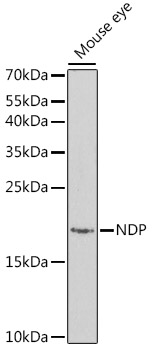Signal Transduction Antibodies 2
Anti-NDP Antibody (CAB1964)
- SKU:
- CAB1964
- Product Type:
- Antibody
- Reactivity:
- Mouse
- Host Species:
- Rabbit
- Isotype:
- IgG
- Research Area:
- Signal Transduction
Description
| Antibody Name: | Anti-NDP Antibody |
| Antibody SKU: | CAB1964 |
| Antibody Size: | 20uL, 50uL, 100uL |
| Application: | WB |
| Reactivity: | Mouse |
| Host Species: | Rabbit |
| Immunogen: | Recombinant fusion protein containing a sequence corresponding to amino acids 25-133 of human NDP (NP_000257.1). |
| Application: | WB |
| Recommended Dilution: | WB 1:500 - 1:2000 |
| Reactivity: | Mouse |
| Positive Samples: | Mouse liver, Mouse heart, Mouse eye |
| Immunogen: | Recombinant fusion protein containing a sequence corresponding to amino acids 25-133 of human NDP (NP_000257.1). |
| Purification Method: | Affinity purification |
| Storage Buffer: | Store at -20'C. Avoid freeze / thaw cycles. Buffer: PBS with 0.02% sodium azide, 50% glycerol, pH7.3. |
| Isotype: | IgG |
| Sequence: | KTDS SFIM DSDP RRCM RHHY VDSI SHPL YKCS SKMV LLAR CEGH CSQA SRSE PLVS FSTV LKQP FRSS CHCC RPQT SKLK ALRL RCSG GMRL TATY RYIL SCHC EECN S |
| Gene ID: | 4693 |
| Uniprot: | Q00604 |
| Cellular Location: | Secreted |
| Calculated MW: | 15kDa |
| Observed MW: | 18kDa |
| Synonyms: | NDP, EVR2, FEVR, ND, norrin |
| Background: | This gene encodes a secreted protein with a cystein-knot motif that activates the Wnt/beta-catenin pathway. The protein forms disulfide-linked oligomers in the extracellular matrix. Mutations in this gene result in Norrie disease and X-linked exudative vitreoretinopathy. |
| UniProt Protein Function: | NDP: Activates the canonical Wnt signaling pathway through FZD4 and LRP5 coreceptor. Plays a central role in retinal vascularization by acting as a ligand for FZD4 that signals via stabilizing beta-catenin (CTNNB1) and activating LEF/TCF-mediated transcriptional programs. Acts in concert with TSPAN12 to activate FZD4 independently of the Wnt-dependent activation of FZD4, suggesting the existence of a Wnt-independent signaling that also promote accumulation the beta-catenin (CTNNB1). May be involved in a pathway that regulates neural cell differentiation and proliferation. Possible role in neuroectodermal cell-cell interaction. Defects in NDP are the cause of Norrie disease (ND); also known as atrophia bulborum hereditaria or Episkopi blindness. ND is a recessive disorder characterized by very early childhood blindness due to degenerative and proliferative changes of the neuroretina. Approximately 50% of patients show some form of progressive mental disorder, often with psychotic features, and about one-third of patients develop sensorineural deafness in the second decade. In addition, some patients have more complex phenotypes, including growth failure and seizure. Defects in NDP are the cause of vitreoretinopathy exudative type 2 (EVR2). EVR2 is a disorder of the retinal vasculature characterized by an abrupt cessation of growth of peripheral capillaries, leading to an avascular peripheral retina. This may lead to compensatory retinal neovascularization, which is thought to be induced by hypoxia from the initial avascular insult. New vessels are prone to leakage and rupture causing exudates and bleeding, followed by scarring, retinal detachment and blindness. Clinical features can be highly variable, even within the same family. Patients with mild forms of the disease are asymptomatic, and their only disease related abnormality is an arc of avascular retina in the extreme temporal periphery. |
| UniProt Protein Details: | Protein type:Secreted, signal peptide; Secreted Chromosomal Location of Human Ortholog: Xp11.4 Cellular Component: extracellular matrix; extracellular space; cell surface Molecular Function:protein binding; protein homodimerization activity; growth factor activity; frizzled binding; cytokine activity Biological Process: nervous system development; cell proliferation; sensory perception of sound; Wnt receptor signaling pathway; visual perception; cell-cell signaling; positive regulation of transcription, DNA-dependent; positive regulation of transcription factor activity; Wnt receptor signaling pathway through beta-catenin; signal transduction; vacuole organization and biogenesis; placenta development Disease: Exudative Vitreoretinopathy 2, X-linked; Norrie Disease |
| NCBI Summary: | This gene encodes a secreted protein with a cystein-knot motif that activates the Wnt/beta-catenin pathway. The protein forms disulfide-linked oligomers in the extracellular matrix. Mutations in this gene result in Norrie disease and X-linked exudative vitreoretinopathy. [provided by RefSeq, Feb 2009] |
| UniProt Code: | Q00604 |
| NCBI GenInfo Identifier: | 548342 |
| NCBI Gene ID: | 4693 |
| NCBI Accession: | Q00604.1 |
| UniProt Secondary Accession: | Q00604,Q5JYH5, B2R8K6, |
| UniProt Related Accession: | Q00604 |
| Molecular Weight: | |
| NCBI Full Name: | Norrin |
| NCBI Synonym Full Names: | Norrie disease (pseudoglioma) |
| NCBI Official Symbol: | NDP |
| NCBI Official Synonym Symbols: | ND; EVR2; FEVR |
| NCBI Protein Information: | norrin; norrie disease protein; X-linked exudative vitreoretinopathy 2 protein |
| UniProt Protein Name: | Norrin |
| UniProt Synonym Protein Names: | Norrie disease protein; X-linked exudative vitreoretinopathy 2 protein |
| Protein Family: | Norrin |
| UniProt Gene Name: | NDP |
| UniProt Entry Name: | NDP_HUMAN |







